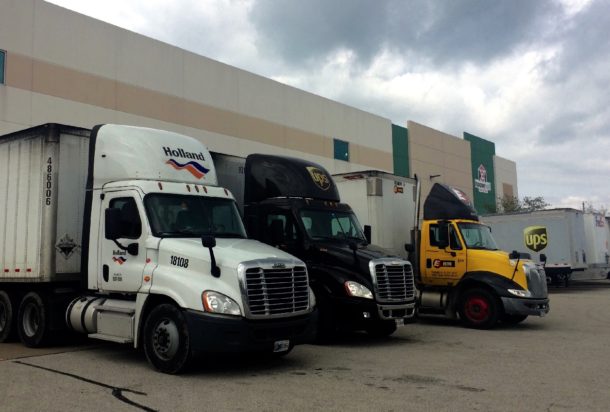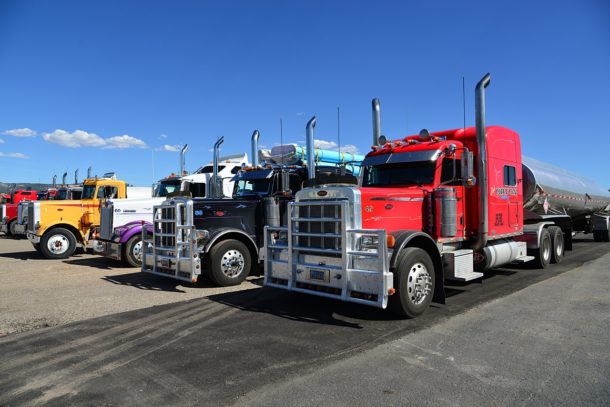Pushing the front corners
When straight line backing and relying mostly on my mirrors to give me the best view of my trailer, my focus switches from “kingpin pressure” to pushing the front corners from one mirror to the other. To keep the trailer pointing where you need it, pay close attention to the movement of the front corners.
Let’s look at some photos from a customer location in Ferguson, Mo.
Watson’s Coatings has been around a very long time.
When driving a big truck around an older city like Saint Louis, you will often encounter properties that were not designed to accommodate them. Keep in mind that when these buildings were built, 53-foot trailers did not yet exist.
The building sits on top of a hill. You will drive up a long driveway to a lower parking lot, and this is what you will see.
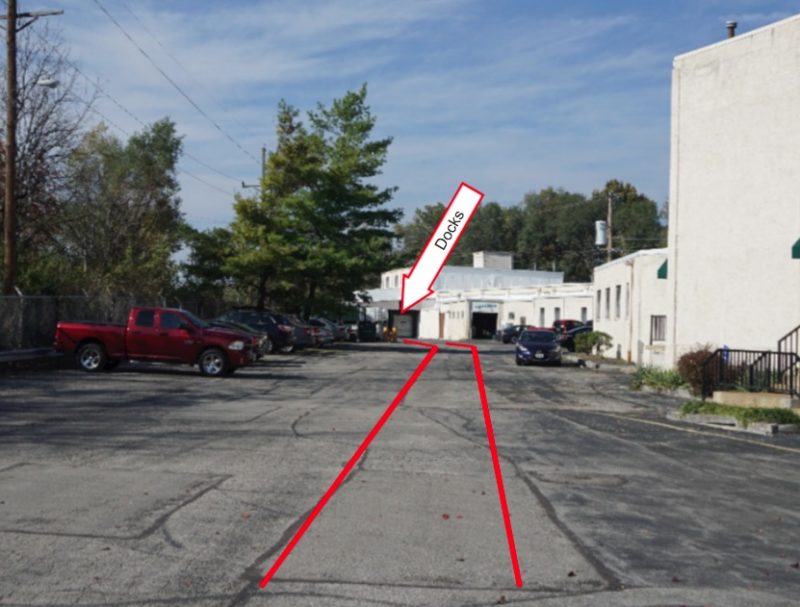
There are two docks. Only one is visible from here. You should get out and walk up the hill so that you can see what obstacles you may encounter and develop a plan of action. There is room to turn around at the bottom and get your trailer pointing up the hill.
I’ve marked an acceptable path that my trailer tires will take in red.
You should always make a mental note of any obstacles that pose a risk. You should not lose sight of these obstacles any longer than necessary in your mirrors.
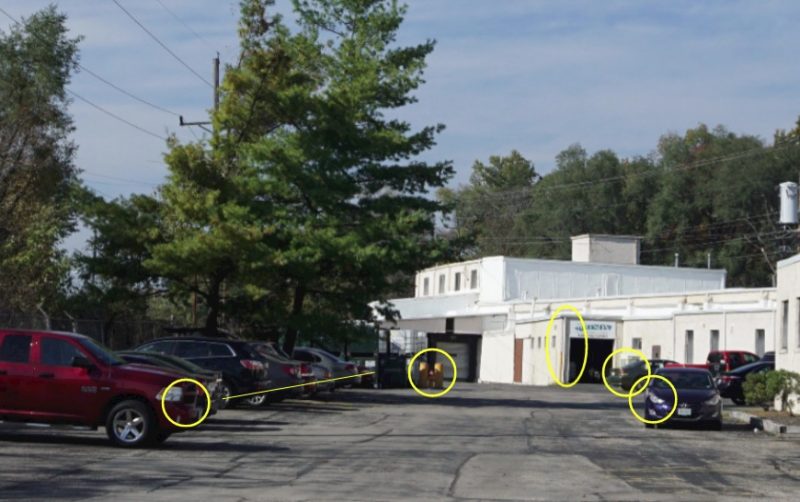
Look for obstacles during leg A of every setup. It only takes a few seconds.
The yellow pole circled in the center of the photo is not only an obstacle; it is an essential landmark in my “plan of action.”
When I walked up the hill to survey the dock area, I decided that I wanted my trailer to stay within a short distance from this pole. When my trailer tires pass the pole, I want to start a gentle offset by pushing the front corner of my trailer within my mirror so that the trailer begins to rotate and point towards the dock.
Now that I have a plan of action and an acceptable path picked out, I will turn the trailer around so that it points in the general direction that I want it to go.
In the next photo, I have finished my set up.
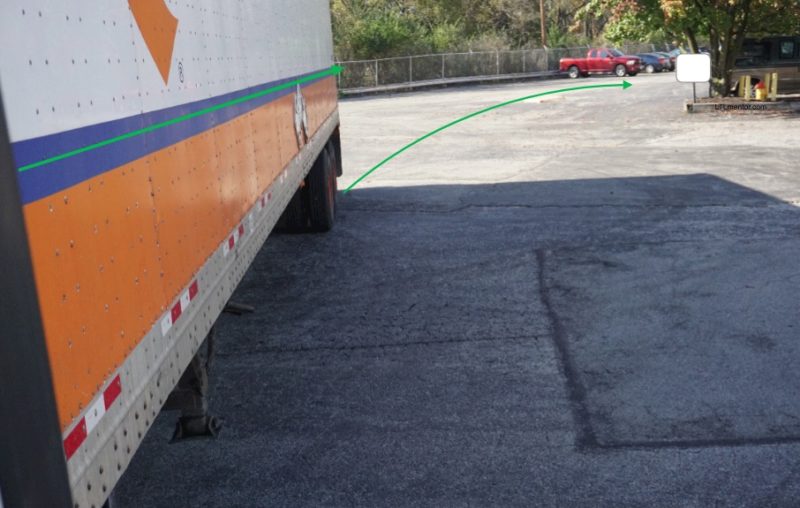
Because of the available space, the best I could do was point the trailer towards the fence. But, I’ve made sure to put a slight left turn in before running out of space to create some offset between the tractor and the trailer. I know I will need that offset to get the trailer tires to follow that curved path up the hill. You need some offset to create more offset. I will rely on the Offset Law and carefully monitor where the trailer is pointing. Side pressure on the kingpin by the tractor will cause the trailer to rotate around the back tandems and follow the curved path laid out by the green arrow on the ground.
I have my window rolled down, and I’m looking rearward out the window.
When the tractor and trailer are offset from each other, the window will give you the best view of the entire trailer. As you get the tractor back toward the front of the trailer, you will rely more on the mirrors. When choosing between window or mirrors, pick the option that gives you the best view of the entire trailer.
When backing near vehicles be on the lookout for pedestrian traffic and roll slowly.
In the next photo, I’m about halfway up the hill. By looking at both mirrors, I can see that my tractor is offset from my trailer towards the right. I know this because the trailer’s sidewall is visible in the right mirror but not visible on the left. Additionally, the trailer’s front corner is visible in the left mirror but not the right.
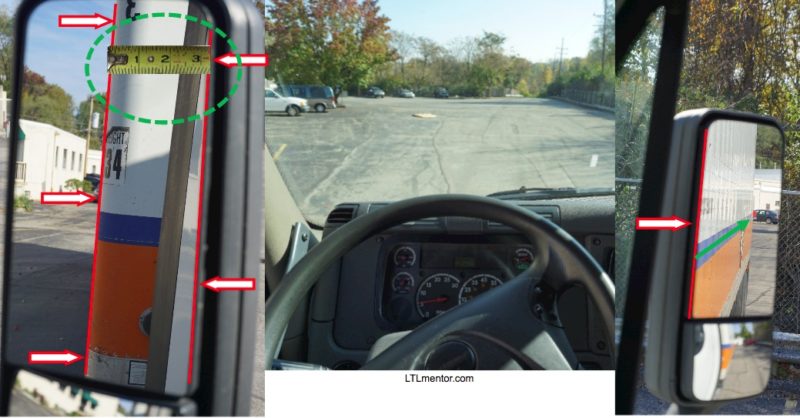
We control precisely where the trailer tires go by moving the front part of the trailer.
My intentions will be pushing the front corners of the trailer to change the direction that it points. I also closely monitor the changing position of both corners relative to the inside edge of the mirror. As one corner starts to disappear behind the tractor in one mirror, it will appear in the opposite mirror.
If you pay attention to this changing front corner position, as well as the speed of its movement, you will come to realize that often, small steering wheel movements are all that is necessary.
Focusing on the front of the trailer may be a new idea to many, but trust me, this is where real control lies. And this is where you should start focusing if you want to master the movement of your trailer.
I’ve added lines and arrows to some areas that I feel deserving of close attention.
Take a look at the left mirror. I have three arrows pointing to a red vertical line. This vertical line is highlighting the outside edge of the front corner of the trailer. To the right of that is a second vertical line with two arrows pointing to it. This line is merely highlighting the inside vertical edge of the mirror, which you will use as a reference point. The distance between these two red lines will change as you push the front corners with your steering wheel.
I have added a section of a measuring tape between the two lines to impress upon you the need to monitor this changing distance as you are backing up. Most new drivers have a difficult time because of over-steering.
This changing distance is a valuable source of information and very high on my priority list every time I back up my trailer.
The green arrow running alongside the trailer is a reminder to always be aware of where the trailer is pointing. (Arrow Awareness)
You should make subtle moves with the front corners to point and roll the trailer precisely towards a predetermined tire path.
(Note about mirror adjustment) Truck driving students are usually taught to adjust both mirrors in such a way that when the tractor and trailer are in line with one another— no side wall of the trailer is visible at all. I Do Not adjust my mirrors this way!
That may be fine for driving down the interstate because it slightly widens my peripheral view out to the sides, but that’s why I have blind spot mirrors and fender mirrors. I back up frequently in places that have many obstacles. I want the mirrors set so that I can see a small amount of sidewall and I want to see my rear tires in the bottom portion of the mirror. If something is going to come into contact with the side of my trailer or I’m in danger of running over something, I want to know it!
In the photo below, my tractor and trailer are inline. I know this because I have about an equal amount of trailer and front corner visible in each mirror. I look down the sidewalls of the trailer the way a marksman looks down the barrel of a rifle.

I can see in the right mirror that the trailer will miss my “landmark” yellow pole on its current trajectory. Just barely! I want to create a little more separation between the trailer and the pole.
I ask myself, “Which way do I need to push the front corners of the trailer for it to point away from the pole?”
Since the trailer rotates around the back tandems, if I pushed the front corners towards the left mirror, the trailer would point directly at the yellow pole. That’s not what I want. I need to push the front corners towards the right mirror so that the trailer will point away from the yellow pole.
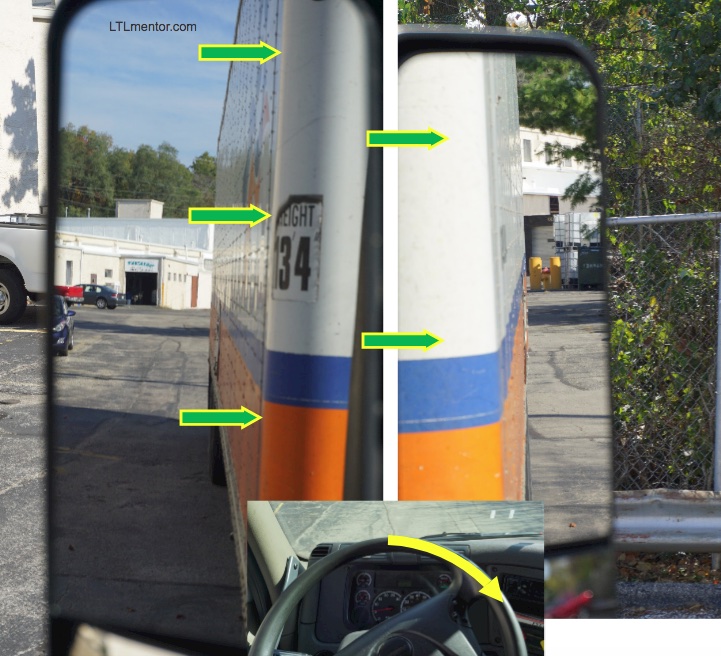
There will be no big turn of the steering wheel here. It will be a slight turn and hold. Letting the Offset Law do the work for us. Small moves of the steering wheel make the front corners move slowly and give you more time to react.
To push the front corner, put your hand at the top of the steering wheel for a reference point, and move your hand towards the mirror that you want the corner to move towards.
You get back to the front of the kingpin by working within your mirrors. Do not use any “opposite thinking”. There’s no need to think about the fact that things are reversed. To eliminate confusion, think about which direction the front corners needs to move to point the side of the trailer towards your tire target or predetermined path.
As the front corner is disappearing in one mirror, it will appear more in the opposite mirror. You must be aware of this movement and correct it to stop the corners from moving when they are precisely equal in both mirrors. If you see a little more corner in one mirror that the other— then you still have offset. If you have any offset, you are pushing against the side of the kingpin, and you are going to make the trailer slightly rotate and knock it off course. You must commit to paying attention to details.
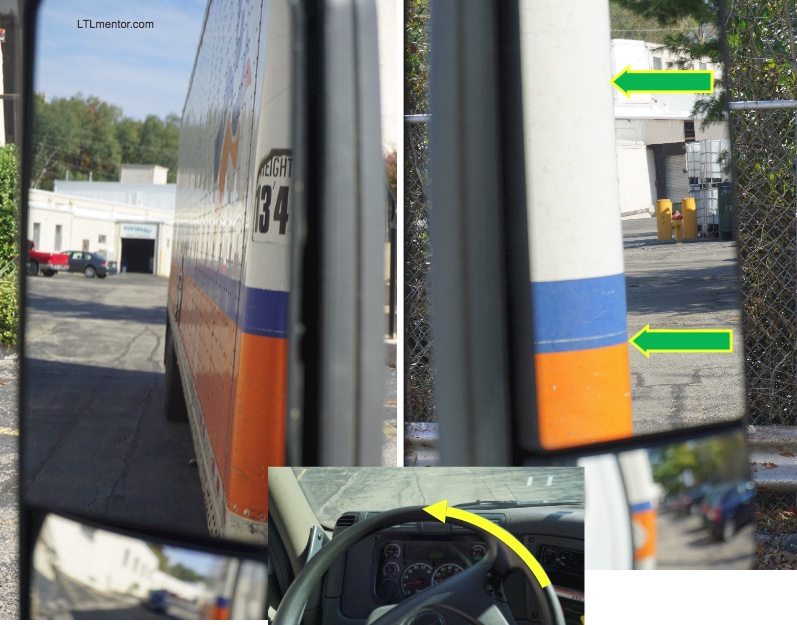
When the trailer tires are on the correct path, and the trailer is pointing where it needs to be, get back to the front of the kingpin.
Do not over-steer. Be aware of your hands and the steering wheel. You cannot make complete revolutions of the steering wheel. It would be too much in this situation. Try a quarter turn, with your hand at 12 o’clock, move it to 9 and hold it. Observe the corners moving relative to your reference point of the inside edge of the mirror. And keep your head swiveling from one mirror to the other. Don’t focus on one mirror more than another.
Keep Rolling— slowly
You must be rolling to see the corners move.
One of the worst mistakes students make while doing a backing maneuver is to crank on the steering wheel while at a complete stop.
Here is an example of what they sometimes do:
They will creep backward a very short distance— then completely stop.
Crank the steering wheel for two or three complete revolutions, roll backward a short distance, and stop again. Crank the steering wheel in the opposite direction. Stop and repeat. It can be frustrating to watch.
This behavior is an example of over-steering, and it wears out the steer tires.
Keep rolling and react to what you see in your mirrors. It takes less steering wheel manipulation than most beginners think to get the front corners to start moving. Try turning the wheel a quarter of a turn and hold it. Observe what you see in your mirrors as you are slowly rolling backward.
Continue to develop these new awareness, and don’t give up. It will all fall into place sooner than you think.
If you find this post helpful, please share it with another student.
Contact me with any questions or suggestions.
Keep on keepin’ on.


